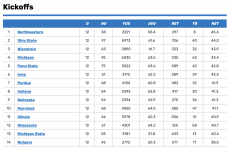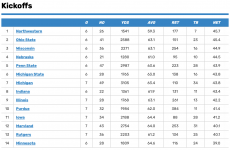fmlizard
Well-known member
- Joined
- Jan 19, 2012
- Messages
- 7,350
- Reaction score
- 9,445
- Points
- 113
I was playing around with the Big Ten team stats now that the regular season is in the books. There were a lot of strong performances around the squad, but one player and one unit stood out head-and-shoulders above all other Big Ten teams.
Dragan Kesich was dragon-mode all year long. Just blew away every other kicker in the Big Ten in touchback %. Kesich had 86.6% of his kickoffs end in touchbacks, with his next closest competitor well behind. (Maryland - 69% and Michigan - 67%). Conference average was below 50%.
What did this get the Gophers opponents? The third best starting field position on kickoffs in the conference.
All these kickoffs on average netted the Gophers 40.7 yards, or nearly exactly what a touchback nets (40 yards, or the distance from the 35 to the 25). This means opponents started on the 24.3 after our kickoffs, on average.
Most teams with much worse kicking performances had their opponents starting between the 20 and 25 on average. The worst touchback kicker in the Big Ten (Northwestern, 21%) yielded the worst opponent starting field position off kickoffs, or the 19.6 yard line on average.
Does it make analytics sense in college football to avoid touchbacks and run down and cover?

Dragan Kesich was dragon-mode all year long. Just blew away every other kicker in the Big Ten in touchback %. Kesich had 86.6% of his kickoffs end in touchbacks, with his next closest competitor well behind. (Maryland - 69% and Michigan - 67%). Conference average was below 50%.
What did this get the Gophers opponents? The third best starting field position on kickoffs in the conference.
All these kickoffs on average netted the Gophers 40.7 yards, or nearly exactly what a touchback nets (40 yards, or the distance from the 35 to the 25). This means opponents started on the 24.3 after our kickoffs, on average.
Most teams with much worse kicking performances had their opponents starting between the 20 and 25 on average. The worst touchback kicker in the Big Ten (Northwestern, 21%) yielded the worst opponent starting field position off kickoffs, or the 19.6 yard line on average.
Does it make analytics sense in college football to avoid touchbacks and run down and cover?


